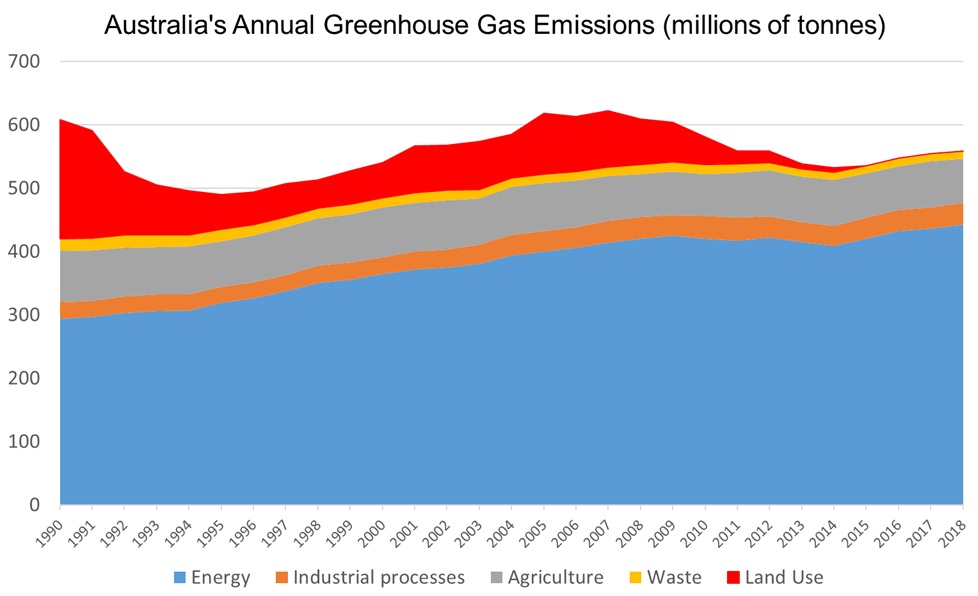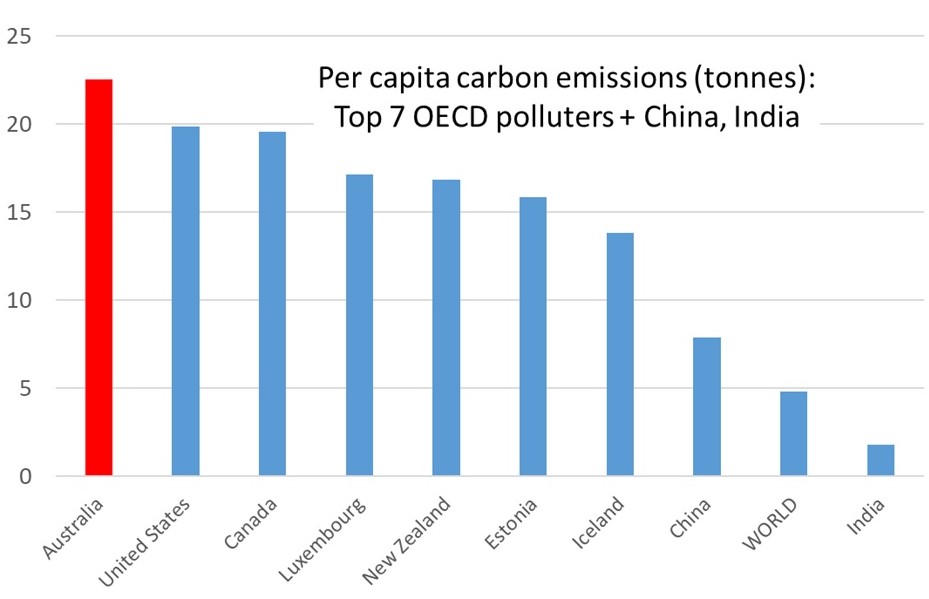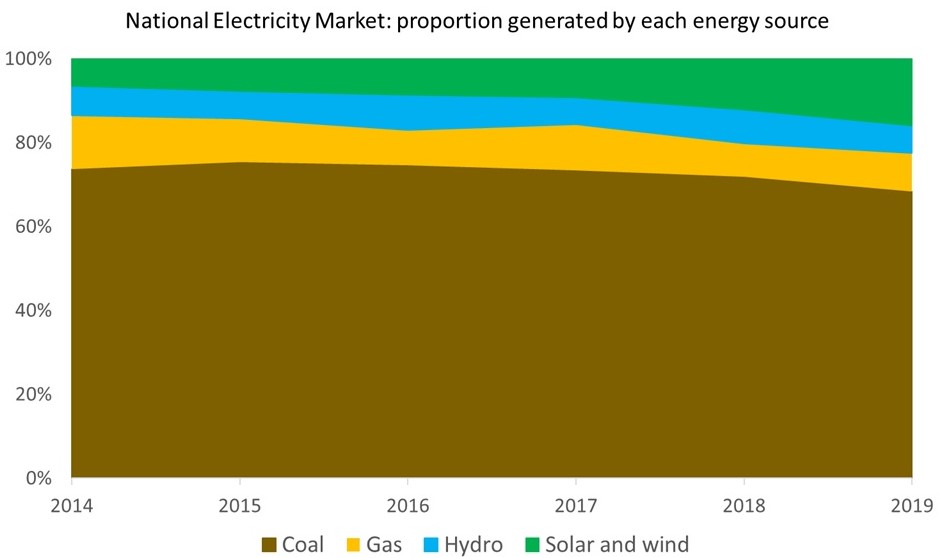
Following the recent bushfire crisis and the upsurge in climate concern, the federal Coalition wants to give the impression that it is acting on climate change. Andrea Bunting debunks 14 claims made by the Coalition government in an email sent to a constituent.
Claim 1: “We will beat our 2020 Kyoto target by 411 million tonnes, or close to 80% of a full year’s emissions.”
Reply: This claim relies on three things: a target with virtually no ambition; very creative accounting; and reduced land clearing. Meanwhile, emissions from other sources have risen substantially.
Australia was initially allowed an 8% increase in emissions for the first Kyoto target — unlike most other developed countries.
As to the creative accounting, Climate Analytics has concluded: “Any claim of overachievement under the Kyoto Protocol does not represent any real emission reductions but is technical only, resulting from anomalies under Kyoto accounting rules and deliberate accounting choices Australia made.”
It will be virtually impossible for Australia to meet its earlier commitment of reducing emissions by 5% between 2000 and 2020. The government’s 2020 projection represents a 1.2% decrease.
Australia depends heavily on land use changes for emission reductions (mainly due to reduced land clearing). Australia lobbied intensely at the 1997 Kyoto climate conference to count land use changes as emissions.
Figure 1 shows how land use changes have been the main reason for the ups and downs in Australia’s annual emissions. Land use emissions were high in 1990 and 2005 (both base years). Australia’s targets are relative to these base years.
251 figure 3 Australia emissions by sector to 2018.jpg

2. “We are on track to meet our Paris target of reducing emissions by 26–28 per cent on 2005 levels by 2030.”
This is partly due to the choice of 2005 as the base year — when land use emissions were high. Australia is also trying to use carryover credits from the Kyoto periods to meet its Paris target. If it is allowed to get away with this, Australia doesn’t need to do much else to meet its target.
No other country is actively pushing to use Kyoto carryover credits. At the Madrid United Nations climate conference, about 100 other countries tried to prevent Australia from doing so. The issue remains unresolved.
3. “Emissions are coming down. They are lower than when the Coalition came into government in 2013 and are lower than any year when Labor was last in government. In 2018–19, emissions were down 15.2% since their peak in 2006–07. Emissions per person and per dollar of GDP were also at their lowest levels in 29 years.”
Since the Coalition came to power in 2013, the trend in emissions is slightly upwards.
Depending on the choice of the base year, it is possible to calculate all sorts of misleading figures. So let’s look at the trend in energy emissions (the biggest sector) since 2005. Electricity emissions have dropped by 1% per year due to the growth in renewables and coal-fired power station closures. Non-electricity emissions are growing at 1.8% — faster than population growth.
Even their own MPs don’t believe their claims. An unnamed government MP told the Sydney Morning Herald: “We say emissions are going down and they are going up. We say investment in renewables is higher than ever but it's falling because of the policy mess we have created”.
Australia’s emissions per capita are double those of Japan and triple those of France and Germany. Australia’s emissions per unit of GDP are also about double those of Germany and Britain.
4. “Australia’s share of global emissions was about 1.3 per cent”
Australia’s per capita carbon emissions are the highest in the OECD.
251 figure 1 per capita emissions.jpg

As a long-term high emitter, Australia has contributed significantly to the increased carbon in the atmosphere — unlike most developing countries.
Australia is also partly responsible for other countries’ emissions because it imports most manufactured products. The emissions used in their manufacturing do not count towards Australia’s total.
The Coalition government likes to claim that Australia is too small to bother. But Australia’s behaviour on the world stage has been very negative. It has long tried to undermine global climate action by arguing for special treatment. This bad behaviour encourages a few other countries to also undermine the rules.
Climate negotiator Dean Bialek noted: “Australia’s dodgy accounting proposals are stoking India — and other big emitters — to pollute more”.
As the world’s third-largest exporter of fossil fuels, Australia helps promote fossil fuel usage elsewhere. According to the Guardian: “Not only does Australia encourage other countries to buy its toxic coal and gas, but it works tirelessly in international forums including the G20 and the UN climate system to ensure that its huge fossil fuel exports are not discussed, let alone criticised.”
5. “We have the world’s highest uptake of rooftop solar — one in five homes have solar on their roofs”
This is a credit to homeowners. However, rooftop solar generates just 5% of Australia’s electricity.
Householders lead the world in installing rooftop solar. The reasons include frustration with weak climate policies, rising electricity bills, and the availability of feed-in-tariffs (which are a state matter). The states also have other subsidy schemes.
The federal government has provided subsidies through the Small Scale Renewable Energy Scheme, introduced by the previous Labor government. The Coalition cannot take credit for it.
6. “In 2018, we set a new record for renewable energy with 5.1 gigawatts (GW) accredited, more than double the previous record of 2.2GW in 2017. In 2018 our per capita investment in renewable energy was among the world’s best, and is more than double that of countries like the United Kingdom, Germany or France.”
There was significant renewable energy investment in 2018 because the Renewable Energy Target (RET) was due to expire. Investment plummeted in 2019. The RET scheme is now full. The Coalition government has nothing to replace it.
Renewables were supported by the RET, which was introduced by Kevin Rudd’s Labor government and watered down by the Coalition. Australia reached the target last September. Several states now have RETs. The Coalition cannot take any credit for this.
Figure 3 below shows how much electricity has come from different sources over the past six years. Generation is still dominated by coal, and this dropped only slightly. Australia has a long way to go to achieve 100% renewable energy.
7. “We have invested nearly $7.2 billion in clean energy. We recently committed a further $1 billion improve reliability of the electricity grid through projects like pumped hydro, batteries and transmission upgrades, all of which support more renewable energy”
We can thank the Julia Gillard Labor government for establishing the Clean Energy Finance Corporation (CEFC), which provided this investment. Prime Minister Tony Abbott’s Coalition government tried unsuccessfully to abolish the CEFC. Then it tried to wreck it by putting onerous requirements on it. Recently, the Coalition has started praising it. Go figure.
The federal government provided an extra $1 billion for grid reliability last October. This is called the Grid Reliability Fund. This funding will be useful if it enables more use of variable renewable energy, but not if it funds gas-fired power.
8. “We are investing nearly $1.5 billion to advance Snowy 2.0 and the Battery of the Nation. At 2,000 MW and 2,500 MW respectively, these will generate enough power for one million homes.”
Australia desperately needs much more utility-scale storage (such as pumped hydro) to grow solar and wind power. These two projects will help. But Australia needs a plan for storage distributed throughout the network so it can move rapidly to 100% renewables.
9. “Our new $2 billion Climate Solutions Fund supports a range of practical emissions reduction projects, such as capturing methane from landfill and storing carbon in forests and soils. This builds on our previous $2.55 billion Emissions Reductions Fund that has already secured more than 190 million tonnes of emissions reductions, of which over 80 per cent will be delivered by the agricultural and land sectors.”
Most projects under these funds are for vegetation, such as tree planting. Some were reportedly destroyed by recent bushfires. This highlights the risk of relying on emission reduction projects that are impacted by climate change.
Drawing down carbon in the agricultural and land sectors is important, but will not be enough by any means. What is the plan for reducing fossil fuel use?
10. “In November we released our National Hydrogen Strategy and increased our funding to support investment in this new technology to $500 million.”
Producing hydrogen from renewable energy can be useful for storage. The Coalition needs to rule out hydrogen produced from fossil fuels. The National Hydrogen Strategy refers to “clean hydrogen”, which includes making hydrogen from coal and gas, and using “substantial” carbon capture and storage (a highly contested technology). The assumed rates of carbon dioxide capture may well be unachievable.
11. “In 2020 we will release our National Electric Vehicle Strategy to ensure a sustainable transition to new vehicle technology.”
Australia is far behind other countries in moving towards cleaner vehicles. The Coalition’s attitude to electric vehicles has been abysmal. During the 2019 election campaign, they ran a fear campaign on electric vehicles.
Electric vehicles can run on renewable energy, but require significant resources to build the vehicles and roads. We desperately need much more and better public transport.
12. “We are on track to exceed our 2015 commitment to spend around $1 billion over five years by 2020 on helping developing countries address climate change, including $300 million over four years in the Pacific. We also recently announced an additional $500 million over five years from 2020 for climate and disaster resilience in the Pacific.”
The Pacific Islands are justifiably very angry at Australia for obstructing action on climate change. Indeed, some leaders publicly expressed this at the 2019 Pacific Islands Forum.
The Coalition has stopped funding the Green Climate Fund, which is intended to help poorer countries become more resilient to climate change impacts. This is despite its earlier pledge of $200 million.
The Coalition has obstructed international efforts to get funds to help developing countries recover from climate disasters (known as Loss and Damage).
13. “Australia is a world leader in climate science and climate adaptation.”
The Coalition has defunded or reduced funding for climate science and resilience.
The Coalition axed the main organisation doing research on climate adaptation, the National Climate Change Adaptation Research Facility. Under Abbott, the Coalition cut funds to CSIRO climate science, although Turnbull later reduced this cut. The Coalition axed the Climate Commission, a key climate science communication body.
14. “We want to get our emissions down without removing the industries which they and their communities rely on for their livelihoods.”
The world is increasingly transitioning to clean technologies. What is the plan to help Australia transition in an orderly and fair way?
The fossil fuel industry has a relatively small workforce, but its workers are clustered in specific regions. The biggest threat to their jobs is automation, which has already led to significant loss of employment. Coal exports will undoubtedly decline due to decisions made by countries that currently import Australian coal.
To avoid workers in coal communities bearing the brunt of the transition, governments need to plan for the transition. The Coalition has no plan for a transition.
The Latrobe Valley in Victoria received $266 million funding for its transition away from coal. Other coal communities are developing their own transition plans, most recently in Collie, Western Australia. Yet the Coalition remains in denial. By ignoring the inevitable and refusing to plan, the Coalition is jeopardising the future of these communities, and more.
[Andrea Bunting is a member of Climate Action Moreland.]
